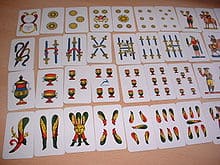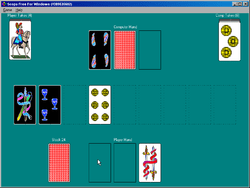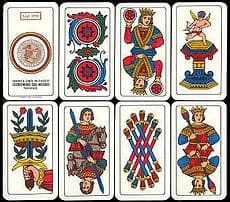Scopa
|
| Origin |
Italy |
| Alternative names |
Skopa |
| Type |
Fishing |
| Players |
2,3,4, or 6 |
| Cards |
40-card |
| Deck |
Italian |
| Play |
counter-clockwise |
| Card rank (highest to lowest) |
R C F 7 6 5 4 3 2 1 |
| Related games |
| Cassino |
Scopa is an Italian card game, and one of the two major national card games in Italy. It is also popular in Brazil, brought in by Italian immigrants, mostly in the Scopa di Quindici variation. Scopa is also played in countries like Libya and Somalia. It is played with a standard Italian 40-card deck, mostly between two players or four in two partnerships, but it can also be played by 3, 5, or 6 players.
The name is an Italian noun meaning "broom", since taking a scopa means "to sweep" all the cards from the table. Watching a game of scopa can be a highly entertaining activity, since games traditionally involve lively, colorful, and somewhat strong-worded banter in between hands. However, skill and chance are more important to the outcome of the game.
Cards
 "Napoletane"
"Napoletane" cards by Modiano
A deck of Italian cards consist of 40 cards, divided into four suits. Neapolitan, Piacentine, Triestine, and Sicilian cards are divided into Coppe (Cups), Ori or Denari (Golds or Coins), Spade (Swords) and Bastoni (Clubs), while Piemontesi, Milanesi and Toscane cards use the 'French' suits, that is Cuori (Hearts), Quadri (Diamonds, literally "Squares"), Fiori (Flowers) and Picche (Spades, literally "Pikes").
The values on the cards range numerically from one through seven, plus three face cards in each suit: Knave [Fante in Italian] (worth a value of 8), Knight [Cavallo in Italian] in the Neapolitan-type decks or Queen [Donna in Italian] in the Milanese-type decks (worth 9), and King [Re in Italian] (worth 10). A Knave is a lone male figure standing. The Knight is a male figure riding a horse; the Queen is a female figure. The King is a male figure wearing a crown. To determine the face value of any numeric card, simply count the number of suit icons on the card. Since the Coins are important in winning some points, the cards of that suit are also nicknamed as "bello" (handsome): so, "il settebello" is the Seven of Coins, "l'asso bello" is the Ace of Coins/Diamonds.
Gameplay
All players arrange themselves around the playing surface. If playing in teams, team members should be opposite each other. One player is chosen to be the dealer.

Initial setting of the game
Beginning with the player on his right, and moving counter-clockwise, the dealer deals out three cards to each player, one card at a time. During this deal, the dealer will also place four cards face up on the table. A table card may be dealt before the deal begins, immediately after dealing a card to him but before dealing to the next player, or after dealing all players all three cards.
As it is impossible to sweep in a game where the initial table cards include three or four kings, such a deal is considered invalid. The cards are re-shuffled, and the dealer deals again.
The player to the dealer's right begins play. This player has two options: Either place a card on the table, or play a card to capture one or more cards. A capture is made by matching a card in the player's hand to a card of the same value on the table, or if that is not possible, by matching a card in the player's hand to the sum of the values of two or more cards on the table. In both cases, both the card from the player's hand and the captured card(s) are removed and placed face down in a pile in front of the player. These cards are now out of play until scores are calculated at the end of the round. If by capturing, all cards were removed from the table, then this is called a scopa, and an additional point is awarded at the end of the round.

Opponent is capturing two cards with one card from his hand (1+3=4).
- Example: The player's hand contains the 2 of coins, 5 of swords, and 7 of clubs (or batons). On the table are the ace of coins, 5 of cups, and 6 of swords. The player's options are:
- Place the 2 of coins on the table;
- Capture the 5 of cups using the 5 of swords, and place both cards face down in front of him;
- Capture the 6 of swords and ace of coins using the 7 of clubs, and place all three cards face down in front of him.
Note that it is not legal to place on the table a card that has the ability to capture. For example, if a 2 and a 4 are on the table and a player holds a 6, the player must either take that trick or play a different card from his hand.
In any circumstance in which a played card may capture either a single or multiple cards, the player is forced to capture only the single card. For example, if the cards on the table are 1, 3, 4, and 8 (Knave, or Fante in Italian), and the player plays another Knave, the player is not allowed to capture the 1, 3, and 4, even though their total does add up to 8. Instead, the player is only allowed to capture the Knave.
After all players have played all three cards, the dealer deals out three more cards to each player, again beginning with the player to his right. That player then begins play again. No additional cards are dealt to the table. This process is repeated until no cards remain in the deck.
After the dealer has played the final card of the final hand of the round, the player who most recently captured is awarded any remaining cards on the table, and points are calculated for each player or team. If no team has yet won the game, the deal moves to the right. The new dealer shuffles and deals the cards as described above.
Scoring
Points are awarded at the completion of each deal. If playing in teams, the team members combine their captured cards before counting to calculate points. Players get one point for each "scopa".
In addition, there are up to four points available for the following, each worth 1 point apiece:
- (a) captured the greatest number of cards.
- (b) captured the greatest number of cards in the suit of coins.
- (c) captured the seven of coins ("sette bello").
- (d) obtained the highest "prime" (literally, primiera), erroneously referred to as simply "capturing the majority of sevens".
If two or more teams or players capture the same number of cards, same number of coin cards, or the same prime value, no point is awarded for that result, e.g. if both Team 1 and Team 2 capture 20 cards total, neither gets a point for the most cards.
The "prime" for each team is determined by selecting the team's "best" card in each of the four suits, and totaling those four cards' point values. When calculating the prime, a separate point scale is used. The player with the highest number of points using this separate point scale gets one point toward the game score.
The most common version of the separate scale is:
- Seven (sette) = 21 points
- Six (sei) = 18 points
- Ace (asso) = 16 points
- Five (cinque) = 15 points
- Four (quattro) = 14 points
- Three (tre) = 13 points
- Two (due) = 12 points
- Face cards = 10 points
If one team captures the sevens of cups and coins, the six of clubs and the ace of swords, that team's prime is (21 + 21 + 18 + 16) = 76.
Other versions of the prime's point scale exist. Most use the same ranking of cards but have variant scores, e.g. 0 points for face cards instead of 10. A variant that is popular in America but disliked by purists is to award the prime to the person with the most sevens, or the person with the most sixes if there is a tie, down to aces, and so on.
Obviously, the seven of coins is the most valuable card in the deck, as it alone contributes to all the four points. A player or team can win the "prime" even with only one seven but other useful cards. If one player has three sevens (3x21) and no cards of the fourth suit (sum=63), his opponent can win the "prime" with one seven (21) and three aces (3x16), for his sum would be 69. Therefore, it is a common tactic, while playing the game, to capture aces and sixes whenever possible.
Likewise, if a player is holding a six and there are an ace, a two a three and one four on the table, he should chose the five plus the ace, unless of course he has already taken the seven or the six of the suit of the ace and unless one of the two remaining cards is of the coins suit and he hasn't made the point of coins yet.
In addition to the four standard points (called "punti di mazzo", literally "deck's points"), teams are awarded additional points for every "scopa" they took during game play. A scopa is awarded when a team manages to sweep the table of all cards. That is, if the table contains only a 2 and a 4, and player A plays a 6, player A is awarded a scopa. Clearing the table on the last play of the last hand of a round does not count as a scopa.
The game is played until one team has at least 11 points and has a greater total than any other team. It is important to note that no points, including scopa points, are awarded mid-round; they are all calculated upon completion of the round. For that reason, if the current score is 10 to 9, and the team with 10 points captures the seven of coins or a scopa, the team cannot immediately claim victory. It is still possible that the opposing team could end up with a tied or higher score once all points are calculated.
In some Italian cities before the game the players can agree to play with the "cappotto" variant, in that scenario if a player is winning 7 points to 0, the game can be considered over and the player does not have to reach the total of 11 points.
It is also possible to agree on a different score, usually with increments of five or ten, e.g., 16, 21 or 31 points.
Idioms
Traditionally, one card from a sweep is turned face up in the captured cards, to remind players while calculating points that a scopa was won, and to taunt them. Many players deal the initial table cards in a 2x2 square.
Alternate Variations
There are many variations of scopa. Since there are no formal rules, it is good manners to agree with the other players on the rules that are to be used before starting a game.
Many of the variations here can be combined. For example, a common variant in the Milan area combines "Scopone scientifico", "Scopa d'Assi" and "Napola".
Playing with French-Suited Cards
When playing with a standard 52-card pack with French suits, 12 cards need to be removed from the deck. Easiest for most new players is to remove the face cards, and therefore play with cards ranging numerically from one through ten. More traditional is to remove the eights, nines, and tens from the deck, which yields the 40-card "Milanese" deck. With the Milanese deck the Jack is 8, the Queen is 9, and the King is 10 (note that in some Neapolitan decks, the Jack is called Queen and is worth 8). Regardless of which cards are removed, the diamonds suit are used for the Italian coin suit, making capturing the most diamonds and the seven of diamonds each worth a point.
Scopa d'Assi (Asso piglia tutto)
In this variation of the game, playing an Ace captures all cards currently on the table (and does not count as a scopa).
Depending on other chosen variants, it can happen that an ace is already on the table when one draws an ace. Rules vary as to whether or not the player will take all the cards, but usually the player who only take the ace that is there. This event, that every player will try to avoid, is called burning an ace.
Scopone
The game of Scopone is based on Scopa. In this game, which must be played in 2 teams of 2, players are dealt all nine of their cards at the start of each round. Play proceeds around the table until all players have played all of their cards.
In another form of the game, the scopone scientifico, the players are dealt ten cards each so that none is left.
Scopa d'Assi is mostly played in the latter variant.
Napola
In this variation (also known as Scopone trentino), a team capturing the ace, two, and three of coins achieves the Napola (or Napoli) and is awarded additional points equal to the highest consecutive coin they obtain, e.g. if a team captures the ace, two, three, four, and five, and eight of coins, that team is awarded 5 additional points.
Because of the higher amount of points awarded per game, the game is played until one team has 21 points, rather than 11. Sometimes a team that manages to capture all 10 coins in a single round wins the game immediately.
Additional points
In the Re Bello ("Beautiful King") version, the King of coins also counts as a point, just as does the Seven of coins.
In some regions of Calabria (especially near Cosenza), a point is awarded for the seven of cups in addition to the seven of coins.
Scopa di Quindici
In this variation, the played card does not take a card or set of cards that sum to the value of the card played. Rather, it takes any set of cards including itself that add to 15. If the table is A, 3, 5, 7, playing a 2 would take itself plus the A, 5 and 7 (A + 2 + 5 + 7 = 15).
Cirulla
This Genoese variation is highly popular in Liguria and bordering zones; it is basically a mixture of traditional scopa, "Scopa di quindici" and "Scopa d'assi", plus it awards additional points for the "Grande" (Big One - 5 points go to the player able to take all three figure cards of coins), "Piccola" (Small Ones - 1 point awarded for each consecutive card of coins after the ace, note that's entirely possible for a player to get the "most coins" point but neither the Big One nor Small One bonus due to the opponent securing vital cards in the sequence).
Moreover, Cirulla players whose hand of three cards adds up to less than 7 (9 in some regions) have to put all of them down on the table and mark three points as if he scored that many "scopa". To the end of such calculations the seven of cups (hearts in Milanese-types) counts as "matta" ("joker"): the player decides its value. With such a high degree of point-awarding combinations and the possibility of scoring dozens of points in a single hand Cirulla games are tense affairs, where seemingly desperate situations can be reversed in a matter of minutes and where the ultimate goal can be set at hundreds of points, up to 1001 in some cases.
Libyan Scopa
Scopa is very popular in Libya and is usually played as mentioned above But some local variations were added like for example a) a sweep of Diamonds (sometimes nine are enough) will reset the opponent to zero b) count Scopas based on the value of the winning card c) count Scopa value based on the total number of cards involved.
Scoring the prime
A number of variant point systems are used for calculating the prime, most of which produce the same order of hands. One notable variant that does not produce the same order is to count 0 points for each face card.
Final score
Some play to 16 or 21 points, or even to an arbitrary score agreed to at the beginning of the game.
Computer versions
There is a playable version of Scopa within the Nancy Drew game The Phantom of Venice.
There are apps for Android smartphones, and the Nokia internet tablet running the Maemo operating system, as well as for iOS iPads and iPhones.
Read more:
COMMENTS









 "Napoletane" cards by Modiano
"Napoletane" cards by Modiano Initial setting of the game
Initial setting of the game Opponent is capturing two cards with one card from his hand (1+3=4).
Opponent is capturing two cards with one card from his hand (1+3=4).